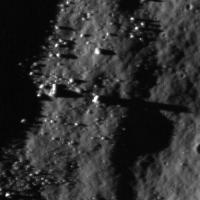Printable Version of Topic
Click here to view this topic in its original format
Unmanned Spaceflight.com _ LRO & LCROSS _ Huge rocks at Mons Hansteen
Posted by: wildespace Jul 4 2013, 08:27 AM
Greetings. What is your opinion on the origin of big rocks that are visible at http://target.lroc.asu.edu/q3/?proj=eqc¢er=-371248.554646,-1523646.568858&zoom=15 at http://en.wikipedia.org/wiki/Mons_Hansteen (also known as the "Arrowhead"). One of the rocks casts a particularly long shadow.
Could they be volcanic plugs, or simply hard rocks exposed through erosion? Would love to hear your take on this. Thanks.
Posted by: nprev Jul 4 2013, 08:50 AM
Um.
Well, they're certainly big rocks. Based on the Moon's general geological history they were probably fragmented & exhumed from an impact.
That's about it. There is no, and has not been over the history of the Solar System, any erosion on the Moon in the rapid terrestrial sense other then impacts from the micro to macro scale.
Posted by: Juramike Jul 4 2013, 03:18 PM
Hansteen rocks are different than most normal basaltic moon rocks.
Check out: Hawke et al., JGR 108 (2003), E7,5069. http://www.spudislunarresources.com/Bibliography/p/78.pdf
This region has rocks that are unusual in that they are made of dacite, which is much more silica-rich lava than basalt. Dacite is a superfine-grained form of granodiorite. Since there is less manganese and iron in the chemical makeup of silica-rich lavas, the silicate-molecule tetrahedrons aren't as bound up by metal ions, so the silica units cling to each other more. (At least that is the simple explanation I have in my head). As a result, the silica-rich lavas are lumpy and flow like toothpaste. The more basaltic lavas are more runny and flow like maple syrup. Dacite and the even more silica-rich rhyolite (superfine-grained granite) form steep-sided plug domes. The plug dome in Mt. St. Helens formed in the 1980's was dacite (http://vulcan.wr.usgs.gov/Imgs/Jpg/MSH/Images/MSH84_st_helens_crater_dome_from_NNW_09-13-84_med.jpg)
Other good candidates for silica-rich volcanic constructs on the Moon are : Marian domes, Oceanus Procellarum [41.4 N, 48 E]; Hansteen alpha, Oceanus Procellarum [12.3 S, 51 W]; Mons Gruithuisenen, Mare Imbrium [36.3 N, 40 W], and Compton-Belcovich Farside [61 N, 99.5 E].
If you poke around those areas, you'll also find some features that look like lumpy big-bouldered plug domes remnants. There is a great example of a big boulder pile just S of Beta dome in the Compton-Belkovic complex.
Posted by: Fran Ontanaya Jul 5 2013, 05:32 AM
I think the terrain just unevenly slopes down in the same direction as the shadows, making them longer by different amounts.
Posted by: JohnVV Jul 6 2013, 10:54 PM
without knowing the exact time the image was taken for that lat / long
And the exact pixel resolution < PPM> or <PPD>
knowing the exact position of the sun above the horizon for the location
i can not calculate the Height
If the Sun is right ON the horizon then they might be rather small .
Posted by: wildespace Jul 6 2013, 11:56 PM
And the exact pixel resolution < PPM> or <PPD>
knowing the exact position of the sun above the horizon for the location
i can not calculate the Height
If the Sun is right ON the horizon then they might be rather small .
I believe you can find those details when looking at the individual NAC strips, such as http://wms.lroc.asu.edu/lroc/view_lroc/LRO-L-LROC-3-CDR-V1.0/M181494651LC or http://wms.lroc.asu.edu/lroc/view_lroc/LRO-L-LROC-3-CDR-V1.0/M166182355RC
But the problem with using shadow length in calculations is that it's falling downhill, therefore being longer than if it were on flat ground.
Powered by Invision Power Board (http://www.invisionboard.com)
© Invision Power Services (http://www.invisionpower.com)

